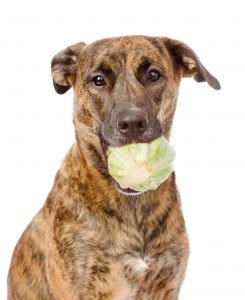Is Cabbage a Safe Food for a Dog?
Cabbage has been an inseparable part of the human diet for centuries. It appeared around 1000 BC somewhere in ancient Greece. Then it was a wild plant, people didn’t even consider eating it. However, now we can’t imagine our life without adding various types of cabbage to our meals. And this is why the chances that your dog tries it are quite large. So, can dogs eat cabbage? Is it safe for them?
 Here’s a short answer – yes, it is safe. It is not just safe, it also contains many useful minerals and vitamins that help pets improve their health, immunity system and maintain your dog’s coat. There are several types of cabbage – savoy, Chinese, brussels sprouts, and any other type. You may even wonder: Can dogs eat purple cabbage? Yes, this type also is safe for dogs, like any other one.
Here’s a short answer – yes, it is safe. It is not just safe, it also contains many useful minerals and vitamins that help pets improve their health, immunity system and maintain your dog’s coat. There are several types of cabbage – savoy, Chinese, brussels sprouts, and any other type. You may even wonder: Can dogs eat purple cabbage? Yes, this type also is safe for dogs, like any other one.
How to Cook Cabbage so That Your Dog Likes It?
We already figured out can dogs eat cabbage. But how to prepare it so that your dog likes it? There are a couple of ways of preparing cabbage for a dog. You can give it raw, but very little percent of dogs like it that way. Also, you can try to steam, boil or bake this vegetable. When you cook it, stick to the following suggestions:
- The best way to serve cabbage to a dog is to steam it. This method of cooking prevents the vitamins from destroying, and it will never hurt your dog’s digestive tract. Moreover, it may even help your dog with digesting food.
- Can dogs eat raw cabbage? Yes, of course. And it will be as good for the dog as giving it steamed.
- Any of the cabbage types are rich in potassium, fiber contains many essential vitamins and antioxidants. All of its constituents help to fight free radicals in the blood and help to prevent various diseases, including cancer.
- If you choose to boil the cabbage, don’t add any salt, sugar, or spices.
- To avoid the occurrence of an allergic reaction, be sure to consult a veterinarian before introducing cabbage, or any other new food, to the dog’s diet.
How Much Cabbage Can a Dog Eat?
The idea of feeding your dog your leftovers which contain cabbage and were cooked the day before yesterday is definitely not a good one. If you are giving cabbage to your dog for the first time, just take the usual cabbage, rinse it thoroughly underwater, and chop into small pieces. The most popular ways of serving this vegetable are raw or stewed.
Cabbage has a tendency to cause gas, so this vegetable needs to be introduced very slowly and in small amounts. It is best to begin by adding some chopped up cabbage on top of the dog’s favorite food once a day. The amount of cabbage should exceed ¼ cup.
Can My Dog Eat Cabbage?
Any new product, as well as cabbage, must be introduced to your dog’s diet with extreme caution. Remember to observe your pet’s reaction to the new food for 48 hours. The following may occur:
- an allergic reaction
- increased gas formation
If your dog has an unusual behavior after consuming this product, contact a veterinarian immediately.
In order to avoid any bad reaction, it is best to not give cabbage to your pet in huge amounts. For 1-4 week give this product in very small amounts, and only when your dog gets used to it, try to slowly increase the amount of cabbage in its diet.
Which Way is the Best: Cooked vs Raw?
 Can dogs eat cooked cabbage? Or can dogs eat raw cabbage? It is perfectly okay to give your dog cabbage both raw and cooked. However, if you are only introducing this vegetable to your dog’s diet, it is recommended to cook it. This way your dog will digest it way more easily, and it will even help in digesting other food consumed by your dog.
Can dogs eat cooked cabbage? Or can dogs eat raw cabbage? It is perfectly okay to give your dog cabbage both raw and cooked. However, if you are only introducing this vegetable to your dog’s diet, it is recommended to cook it. This way your dog will digest it way more easily, and it will even help in digesting other food consumed by your dog.
The best way is to cook it very lightly. This method makes sure that all of the vitamins and minerals that cabbage contains will be preserved. It is recommended to begin to serve cabbage raw only when some time passes after introducing it cooked so that the dog’s digestive system gets fully accustomed to this vegetable.
Can It Be a Cause for Stomach Problems?
As dogs eat almost the same products every day, when you introduce something new to their diet, some negative reactions may occur. One of them is gas. After eating cabbage, your dog may have some stomach pains due to increase gassiness. Moreover, in some cases, dogs even suffer from diarrhea after consuming cabbage for the first time.
In order to avoid any stomach problems, introduce any type of cabbage in your pet’s diet in very small amounts. And stick to that same amount for some time, so that your dog gets used to such a product.
What is the Best Cabbage Alternative?
Luckily, there are plenty of types of vegetables that can be a great substitute for the usual green cabbage. And all of them can be given to your dog. Here is the list of the most popular cabbage alternatives:
- Napa cabbage
- Kohlrabi
- Chinese Lettuce
- Broccoli
- Brussels sprouts
- Other cabbage types
What about red cabbage? Can dogs eat red cabbage? Or can dogs eat green cabbage? Yes, any type of cabbage is fine for them. If you still have this question left: Can dogs eat cabbage leaves? Let me answer it – yes! Just remember to be very careful when serving it to your dog for the first time. And don’t give it in large amounts to avoid the appearance of gas and other stomach problems.
What Fruits and Vegetables Can Be Harmful to a Dog?
Many people consider dogs omnivorous. They eat both meat and vegetables. Also, they do not mind to take a bite of something from the table. However, it is not completely safe for your dog to eat everything that you do.
The first reason for this is that most of the dishes that we cook for ourselves contain salt, pepper, and other spices. If a dog consumes food with those additives, such food can harm your dog’s digestive tract pretty harshly.
The other reason why you should avoid giving everything to your dog is that not every food is okay for your pet. As much as you want to give your little friend to try something new, most foods in your diet are forbidden for dogs.
Never Give Your Dog:
- Mushrooms. They may be very toxic for your pet.
- Nuts. They are not useful for dogs.
- Onions. This product can cause anemia.
If your dog is prone to allergies, you must be even more careful with feeding him. You must avoid all products that may cause an allergic reaction.
Most of the fruits and vegetables can be safely given to your dog. Only remember that you must introduce one new food at a time and observe your pet closely for the occurrence of any reactions.
If your dog is prone to allergies, do not feed or be very careful with feeding such products:
- Fruits, especially citrus ones. Many pets do not mind eating oranges. Unfortunately, not all dog owners know what side effects may occur if their dog has an allergic reaction after eating this fruit. Many pets suffer from bloating after consuming citrus fruits.
- Herbs, or any other spices. In general, it is not a good idea to give your dog any spices. However, in some cases, herbs are great for cleansing the intestines of excess food residue. Also, it is best to not allow your dog to consume plants growing on your lawn, as they might contain harmful bacteria and viruses.
The one vegetable that is completely safe for any dog in small amounts is cabbage. You may wonder: Can dogs eat napa cabbage? Yes, any type of cabbage is very safe for any dog and even can be useful.
Best Canine Cabbage
 When you go grocery shopping, you see that there are various types of cabbage available. All of those cabbage types are equally great for your canine. Whether you choose broccoli, lettuce, the usual cabbage, or any other type, you may be sure that all of them are filled with antioxidants, minerals, and essential vitamins. If you still are not sure can dogs eat cabbage raw, don’t worry, it is pretty safe for them to consume it raw. However, if you only begin to introduce this vegetable into your pet’s diet it is recommended to cook it.
When you go grocery shopping, you see that there are various types of cabbage available. All of those cabbage types are equally great for your canine. Whether you choose broccoli, lettuce, the usual cabbage, or any other type, you may be sure that all of them are filled with antioxidants, minerals, and essential vitamins. If you still are not sure can dogs eat cabbage raw, don’t worry, it is pretty safe for them to consume it raw. However, if you only begin to introduce this vegetable into your pet’s diet it is recommended to cook it.
Just remember to serve it to your dog in small amounts. If any allergic reactions or stomach problems occur, contact a veterinarian immediately.
No Harmful Spices
Dogs do not need any spices in their food. However, there are some dogs that just refuse to eat their meals without adding some tasty spice to it. But are dogs allowed to consume spices? And is everything okay for them? Read on to get these questions answered.
Remember that pepper and salt are forbidden for dogs or any other pets. Pepper is known to cause irritation to mucous membranes, which will also cause irritation of the dog’s skin, eyes, stomach, liver, urinary organs. Moreover, if you give pepper to your dog frequently, it may provoke the development of ulcers, gastritis and even cancer. Pepper has none whatsoever positive effects on the dog’s organism. And even very hot pepper can affect your pet’s sense of smell. So, it is better to avoid adding pepper to your dog’s food.
When it comes to deciding on whether salt is safe for dogs, there is no simple answer. Some believe that it is necessary to add salt to the dog’s food, while others are firmly convinced that the food that the pet consumes already contains the necessary amount of salt. But, the truth is that salt in excess is very dangerous and may harm the dog’s health. If your dog consumes too much salt, it can negatively affect its kidneys and heart. Sometimes a dog can even get poisoned by salt and can get diarrhea and convulsions. In case something like that happens, contact a veterinarian immediately. So, to be on the safe side, don’t give your dog salt at all, or only very rarely and in very small amounts.
Some other spices that are completely forbidden for dogs include nutmeg and cocoa powder. If your dog ate nutmeg, the following side effects may occur – vomiting, strong abdominal pain, sleepiness. Excessive consumption of nutmeg can be fatal. Cocoa powder effects pets also negatively. Remember, by under no conditions, do not offer your dog chocolate or cocoa powder, they are considered to be toxic. Eating cocoa powder may lead to kidney and heart problems. If You want good nutrition for your mutt, organic dog food will be an optimal choice.
So, when you give your dog cabbage, don’t add any spices to it. Don’t add salt, nor pepper. If your dog will like it without any spices, then great. If he refuses to eat it, try to add some of the chopped cabbage to his usual meal. This way your dog will like it for sure, and you won’t need to add any spices that may harm your dog to it.
 It is every dog owner’s responsibility to know everything about the pet’s nutrition and diet. A lot of people prefer to feed their dogs only natural and organic food, which includes even vegetables. This is why those dog owners begin to question whether that type of food is safe.
It is every dog owner’s responsibility to know everything about the pet’s nutrition and diet. A lot of people prefer to feed their dogs only natural and organic food, which includes even vegetables. This is why those dog owners begin to question whether that type of food is safe.

 Here’s a short answer – yes, it is safe. It is not just safe, it also contains many useful minerals and vitamins that help pets improve their health, immunity system and maintain your dog’s coat. There are several types of cabbage – savoy, Chinese, brussels sprouts, and any other type. You may even wonder: Can dogs eat purple cabbage? Yes, this type also is safe for dogs, like any other one.
Here’s a short answer – yes, it is safe. It is not just safe, it also contains many useful minerals and vitamins that help pets improve their health, immunity system and maintain your dog’s coat. There are several types of cabbage – savoy, Chinese, brussels sprouts, and any other type. You may even wonder: Can dogs eat purple cabbage? Yes, this type also is safe for dogs, like any other one. Can dogs eat cooked cabbage? Or can dogs eat raw cabbage? It is perfectly okay to give your dog cabbage both raw and cooked. However, if you are only introducing this vegetable to your dog’s diet, it is recommended to cook it. This way your dog will digest it way more easily, and it will even help in digesting other food consumed by your dog.
Can dogs eat cooked cabbage? Or can dogs eat raw cabbage? It is perfectly okay to give your dog cabbage both raw and cooked. However, if you are only introducing this vegetable to your dog’s diet, it is recommended to cook it. This way your dog will digest it way more easily, and it will even help in digesting other food consumed by your dog. When you go grocery shopping, you see that there are various types of cabbage available. All of those cabbage types are equally great for your canine. Whether you choose broccoli, lettuce, the usual cabbage, or any other type, you may be sure that all of them are filled with antioxidants, minerals, and essential vitamins. If you still are not sure can dogs eat cabbage raw, don’t worry, it is pretty safe for them to consume it raw. However, if you only begin to introduce this vegetable into your pet’s diet it is recommended to cook it.
When you go grocery shopping, you see that there are various types of cabbage available. All of those cabbage types are equally great for your canine. Whether you choose broccoli, lettuce, the usual cabbage, or any other type, you may be sure that all of them are filled with antioxidants, minerals, and essential vitamins. If you still are not sure can dogs eat cabbage raw, don’t worry, it is pretty safe for them to consume it raw. However, if you only begin to introduce this vegetable into your pet’s diet it is recommended to cook it.







